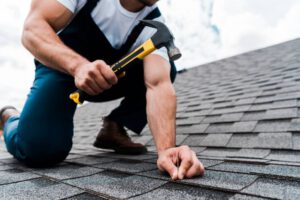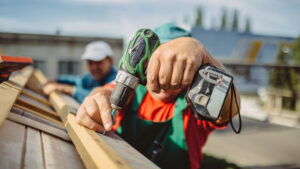Many decisions must be made regarding building a new home or replacing an existing roof. One of the most important is choosing a roofing style and material.
There are a variety of roof styles, each with pros and cons. Let’s take a look at some of the most popular. Visit https://roofx.com/ to learn more.

The gable roof has two peaked sides that meet at a central ridge line. The sloping sides create end walls to form an “A” shape with a triangular protrusion at the top of each end. A gable roof is a common choice for residential homes, but it works well on smaller commercial buildings like garages and workshops.
This style of roof is very easy to frame because it uses basic construction materials and requires less labor than other types of roofs. It is also less expensive to build, making it a good choice for homeowners on a budget. Because the angled peak of a gable roof sheds snow and rain easily, it can help prevent leaks that can happen when heavy weight accumulates on the roof.
Another benefit of a gable roof is that it looks beautiful on any house, regardless of its design or size. The roof’s peaks provide attractive architectural details, which is especially true when the roof is used to cover an entryway or other open area of the home.
A gable roof can be constructed in various ways, including front gables, where the gable is above the entrance or primary door. Side gables, which are gable sections placed alongside the home’s side walls. Crossed gables, where two gable roofs come together at an angle. These are more commonly seen on homes with wings or attached garages.
The only drawback to a gable roof is that its structure makes it prone to high winds. According to Civil Jungle, this is particularly a problem for houses in regions that experience hurricanes and strong storms. The high winds can cause the ridge board to peel away. This can be avoided by using a high-quality roofing material, such as asphalt shingles or slate shingles, that is resistant to rot and mold.
Hip roofs are a main category of roofing styles, and are distinguished by four sloped sides that meet at one central ridge. This roofing style is ideal for areas that experience a lot of snowfall and heavy rain, as the slanted sides help to keep water and snow away from vulnerable parts of the roof structure. Hip roofs also offer a sense of balance to any home, and are perfect for adding features like dormers and other architectural elements.
The slanted sides of a hip roof help to create a wide attic space, which can be used for storage or even a cozy attic retreat. Additionally, the inward slope of the roof’s sides frees up interior space, which can be a great place for windows or additional dormers. This combination of functional and aesthetic features makes hip roofs an ideal choice for any type of building.
Due to their design, hip roofs are very strong and durable. The slanted sides are self-bracing and distribute weight evenly. This design translates to a sturdy and stable roof that is better equipped to withstand varying weather conditions, and requires less maintenance and repairs than other roofing styles.
Another advantage of hip roofs is their ability to accommodate a variety of building shapes and sizes. This flexibility allows them to match perfectly with almost any style of architecture, and can add a touch of charm to any building.
While hip roofs are a popular roofing option for many homes, there are a few things to consider before choosing this style. For one, hip roofs are usually more expensive to construct than gable roofs. This is due to the fact that they are more complex in design and require more materials than a gable roof. Additionally, they require a professional installation to ensure that the roof is installed correctly.
While there are a number of different hip roof types, the most common is the simple hip. This roof has symmetrical sides that meet at a single ridge. Other variations include the jerkinhead hip, which looks similar to a gable roof but has a hip over the gable, and the cross-hipped roof, which has other ridges at right angles to the main ridge.
Whether you’re looking to build a new home or renovate an existing structure, choosing the right roof style can add both aesthetic value and protection from the elements. However, it’s also important to choose a roof that is suitable for your climate. A roof’s slope (incline angle) and shape play an important role in the way rain, snow and wind are guided away from a home.
Hip roofs are four-sided, and they’re great for snowy or rainy areas. The slopes on all four sides allow for the precipitation to fall easily off the roof, which helps prevent clogging gutters and other drainage problems. Hip roofs are also more sturdy than gable roofs, as they have an inward pitch on all four sides rather than a straight ridge.
Shed roofs are characterized by their sharp downward slope, and they’re often used in conjunction with a box-gable roof to create a more unique look. Architects can also use a shed roof to add more attic space to a property. Shed roofs are popular in Louisiana and Mississippi.
Mansard (French roof) roofs have two slopes on all sides, with the lower section being steeper than the upper portion. This type of roof can be a bit difficult to maintain and is expensive to install.
Pyramid roofs are shaped like a pyramid, and they’re often used for buildings such as observatories and planetariums. Builders can also use them for small additions, such as gazebos.
A turret roof is a type of gable roof with a vertical tower that extends from the structure. The turret is usually designed to provide a view of the surrounding area, and it’s sometimes used as part of the design for castle-like structures. While turrets aren’t commonly seen on residential properties, they can add visual appeal and offer extra protection from the elements.
A flat roof is a roof that is almost level, unlike pitched roofs which have a slope of up to 10 degrees. Modern flat roofs are constructed from a variety of materials, but EPDM synthetic rubber, polyvinyl chloride (PVC) and thermoplastic olefin (TPO) are among the most common choices. These durable materials are designed to withstand harsh weather conditions and can be installed with a waterproof membrane, allowing for use of the roof as an outdoor space.
Because of their compact construction, flat roofs allow for the use of a larger area of rooftop, often with added features like solar panels and garden areas. This can be beneficial for homeowners who want to increase the living space of their home, but may not have the room on their block to accommodate a full-sized pitched roof.
Another advantage of a flat roof is that it can be accessed more easily. This allows for regular inspections and maintenance to check for leaks or damage. Depending on the design, a flat roof can also be used as an outdoor space for entertaining or relaxing. This is especially beneficial for homes on smaller blocks where it can be difficult to fit in a backyard.
One of the major drawbacks of a flat roof is that it does not drain water as efficiently as a pitched roof. This can lead to problems such as water pooling and ice dams, and may require a more elaborate gutter system or drainage system. Flat roofs are also less insulated than other roofing styles, making them more susceptible to heat loss and cold temperatures.
Some modern designs of flat roofs utilize a layer of insulation under the waterproof membrane, which can help improve the insulation properties of the roof. However, it is important to note that the amount of insulation required depends on the climate where the home is located. A flat roof is more likely to need replacement sooner than a pitched roof, due to the increased likelihood of damage and leaking. It is recommended that a home with a flat roof consult a professional roofing company to explore their options for repair or replacement.


